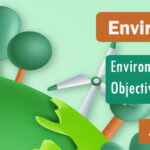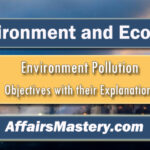Set 6 | Important Environment and Sustainable Development MCQs
Important Environment and Sustainable Development MCQs. Environment and Sustainable Development are pivotal aspects of Environment and Ecology, serving as a cornerstone for success in competitive exams like Civil Services, State exams, SSC, Railways, Banking, and more. Mastering these subjects offers a unique advantage, allowing you to gain invaluable insights into the country’s environmental legacy. With a focus on Environment, Biodiversity, and Ecology, this knowledge not only sharpens your competitive edge but also equips you to excel in these challenging exams.
| MCQs on Environment and Sustainable Development – Objective Questions and Answers |

Q51. N.E.A. Stands for: (Chhattisgarh P.C.S. (Pre) 2003)
[A] National Enquiry Act
[B] National Environment Authority
[C] National Examination Agency
[D] National Event Association
View Explanation
Correct Answer is B.
- The National Environment Appellate Authority (NEAA) better known as NEA was set up by the Ministry of Environment and Forest to address cases in which environment clearances were required in certain restricted areas.
- It was established by the National Environment Appellate Authority Act 1997 to hear appeals with respect to restriction of areas in which any industries, operations or processes shall or shall not be carried out, subject to certain safeguards under the Environment (Protection) Act, 1986.
- On the establishment of National Green Tribunal on 18th October, 2010, under National Green Tribunal Act, 2010, the NEAA stands dissolved.
Q52. The headquarters of the Green Peace International is located at – (U.P.P.C.S. (Mains) 2005)
[A] Amsterdam
[B] Canberra
[C] Ottawa
[D] Nagasaki
View Explanation
Correct Answer is A.
- Greenpeace is a non-governmental environmental organization with offices in over 55 countries. It is headquartered in Amsterdam, Netherlands. Greenpeace states its goal is to “ensure the ability of the Earth to nurture life in all its diversity”.
Q53. Eco-Mark is given to an Indian product which is – (U.P.P.C.S. (Pre) 2012)
[A] Pure and unadulterated
[B] Rich in protein
[C] Environment-friendly
[D] Economically viable
View Explanation
Correct Answer is C.
- Eco-mark is a certification mark issued by the Bureau of Indian Standards (The National Standards Organization of India) to products conforming to a set of standards aimed at ensuring the least impact on the ecosystem. The marking scheme was started in 1991.
Q54. To label environment-friendly consumer products, the Government has introduced: (U.P.P.C.S. (Spl) (Mains) 2004)
[A] Agmark
[B] Eco mark
[C] ISI Mark
[D] Watermark
View Explanation
Correct Answer is B.
- Eco Mark scheme was instituted by the Government of India for labeling of environment friendly products. Notably this scheme is being administered by the Bureau of Indian Standards.
- It is important to mention here that the scheme covers products categories like Soaps and detergents, Food items, Lubricating oils, Packing/packaging materials, Architectural paints and powder coatings, Batteries, Electric and Electronic Goods, Food additives, Wood substitutes, Cosmetics, Aerosols and propellants, Plastic products, Textiles, Fire-extinguisher Leather and coir & coir products.
Q55. According to ‘Sustainable Development Goal (SDG) India Index, 2019’ recently released by NITI Aayog, which State holds the first position? (U.P.B.E.O. (Pre) 2019)
[A] Uttar Pradesh
[B] Bihar
[C] Jharkhand
[D] Kerala
View Explanation
Correct Answer is D.
- SDG (Sustainable Development Goal) India Index 2019-20, released by NITI Aayog, was launched on December 30th, 2019.
- Kerala achieved the first rank in the Index with a score of 70 followed by Himachal Pradesh (69).
- Andhra Pradesh, Telangana and Tamil Nadu were ranked at the third position with the score of 67. In July 2021, the third edition of SDG India Index 2020-21 was released, with a composite score of 75, Kerala topped the NITI Aayog’s Index. Second and third position was obtained by Tamil Nadu and Himachal Pradesh respectively.
Latest SDG India Index for 2023-24
| Goal | State | Union territories |
| Goal 1: No Poverty | Tamil Nadu | Dadra and Nagar Haveli and Daman and Diu |
| Goal 2: Zero Hunger | Kerala | Puducherry |
| Goal 3: Good Health and Well-being | Gujarat | Delhi |
| Goal 4: Quality Education | Kerala, Delhi | – |
| Goal 5: Gender Equality | Nagaland | Lakshadweep |
| Goal 6: Clean Water and Sanitation | Goa | Andaman and Nicobar Islands |
| Goal 7: Affordable and Clean Energy | Andhra Pradesh, Assam, Goa, Haryana, Himachal Pradesh, Karnataka, Kerala, Maharashtra, Mizoram, Punjab, Rajasthan, Tamil Nadu, Telangana, Uttarakhand, Uttar Pradesh, West Bengal | Andaman and Nicobar Islands, Chandigarh, Delhi, Jammu and Kashmir, Ladakh, Puducherry |
| Goal 8: Decent Work and Economic Growth | Himachal Pradesh | Ladakh |
| Goal 9: Industry, Innovation and Infrastructure | Goa | Puducherry |
| Goal 10: Reduced Inequality | Goa | Puducherry |
| Goal 11: Sustainable Cities and Communities | Maharashtra | Chandigarh |
| Goal 12: Responsible Consumption and Production | Tripura | Jammu & Kashmir |
| Goal 13: Climate Action | Sikkim, Tamil Nadu | Chandigarh |
| Goal 14: Life Below Water | West Bengal | – |
| Goal 15: Life on Land | Jharkhand, Tripura | Dadra and Nagar Haveli and Daman and Diu |
| Goal 16: Peace, Justice and Strong Institutions | Gujarat | Ladakh |
Q56. Which of the following states is NOT in the list of top five states on the Sustainable Development Goals Index, 2019-20 India? (U.P.B.E.O. (Pre) 2019)
[A] Gujarat
[B] Himachal Pradesh
[C] Andhra Pradesh
[D] Tamil Nadu
View Explanation
Correct Answer is A.
- See the above explanation.
Q57. Sustainable agriculture means: (U.P.P.C.S.(Pre) 2001)
[A] Self-sufficiency
[B] To be able to export and import under WTO norms
[C] To utilize land so that its quality remains intact
[D] To utilize Wasteland for agricultural purposes
View Explanation
Correct Answer is C.
- Sustainable agriculture is the production of food, fibre or other plants or other animal products using farming techniques that protect the environment, public health, human communities and animal welfare.
- In short, it is proper utilization of the land without affecting the environment so that it’s quality remain intact. Use of chemical fertilizers and pesticides has adversely affected soil health.
- To cope up with this, National Mission for Sustainable Agriculture (NMSA) has been formulated for enhancing agricultural productivity, water use efficiency, promoting nutrient management, and livelihood diversification through the adoption of sustainable development pathways.
Q58. Which one of the following States in India has recently introduced the ‘Greenhouse Farming’: (U.P.P.C.S.(Pre) 2003, U.P.P.C.S.(Pre) 2001)
[A] Haryana
[B] Punjab
[C] Maharashtra
[D] Uttar Pradesh
View Explanation
Correct Answer is B.
- Markfed of Punjab and Sayag Group of Israel signed an agreement to grow vegetables in Greenhouses Farming on 21 April, 2001. Greenhouse farming is the unique farm practice of growing crops within sheltered structures covered by a transparent or partially transparent material.
Q59. Given below are two statements – (U.P.P.C.S.(Pre)2009)
Assertion (A) : Natural vegetation is the true index of climate.
Reason (R) : Water-loving plants are found in a moist climate.
In the context of the above, which one of the following is correct?
[A] Both statements are true and (R) is the correct explanation of (A).
[B] Both statements are true but (R) is not the correct explanation of (A).
[C] (A) is true, but (R) is false.
[D] (A) is false, but (R) is true.
View Explanation
Correct Answer is A.
- Natural vegetation is the true index of climate and an increase in the quantity of carbon dioxide in the atmosphere also affects the natural vegetation.
- Water-loving or Aquatic plants are those which are found mostly in muddy land and near the ponds. They are found in the moist climate. Reduction of moisture in the atmosphere results in the erosion of such plants.
- Hence both Assertion (A) and Reason (R) are correct and Reason (R) is the correct explanation of Assertion (A).
Q60. Urbanization and industrialization are harmful- (U.P.P.C.S. (Mains) 2002)
[A] For balanced development
[B] Environment and ecology
[C] For biodiversity conservation
[D] For all the above.
View Explanation
Correct Answer is D.
- Extreme urbanization and industrialization are harmful to balanced development, environment and ecology and biodiversity conservation.
- Environmental degradation
- Air and water pollution
- Climate change
- Loss of biodiversity
- Public health issues (respiratory and water-borne diseases)
- Urban poverty and social inequalities
- Job displacement
- Strain on natural resources (water and energy)
- Loss of agricultural land
- Increased waste generation
Related articles:
- Set 1 | Important Environment and Sustainable Development
- Set 2 | Important Environment and Sustainable Development
- Set 3 | Important Environment and Sustainable Development
- Set 4 | Important Environment and Sustainable Development
- Set 5 | Important Environment and Sustainable Development
- Set 7 | Important Environment and Sustainable Development
- Set 8 | Important Environment and Sustainable Development
- Set 9 | Important Environment and Sustainable Development




